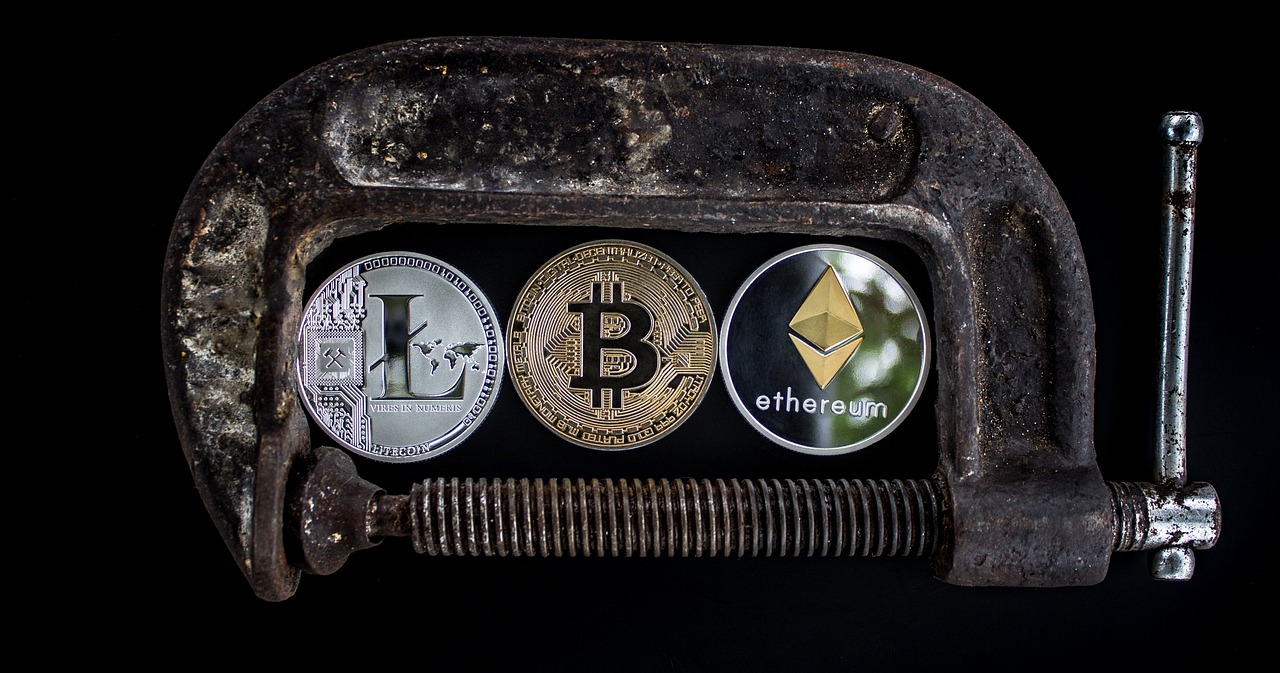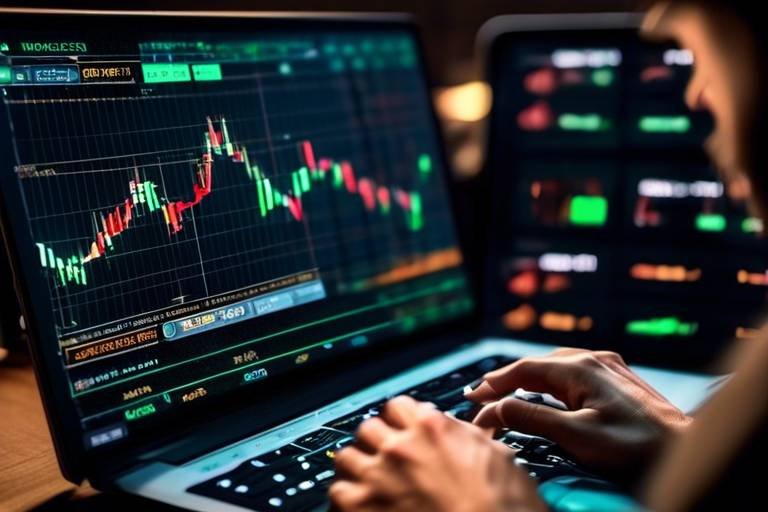Understanding Market Cap - A Key Metric in Crypto
In the ever-evolving world of cryptocurrencies, it's easy to get lost in the jargon and technicalities. But if there's one term that every investor should grasp, it's market capitalization, commonly referred to as market cap. This metric serves as a compass, guiding investors through the vast ocean of digital assets. Simply put, market cap is the total market value of a cryptocurrency, calculated by multiplying its current price by the total circulating supply. Understanding this concept is crucial, not just for seasoned investors but also for newcomers looking to navigate the crypto landscape effectively.
So, why does market cap matter? Well, think of it as a way to gauge the size and stability of a cryptocurrency. A higher market cap often indicates a more established and potentially less volatile asset, while a lower market cap might suggest a riskier investment with the potential for higher returns—or losses. It's like comparing a massive ocean liner to a small fishing boat; the former is likely to weather storms better than the latter. By understanding market cap, investors can make more informed decisions about which cryptocurrencies to invest in based on their risk tolerance and investment goals.
To further illustrate the importance of market cap, let's compare it with other financial metrics that are crucial in the crypto realm. While market cap provides a snapshot of a cryptocurrency's overall value, metrics like trading volume and liquidity offer deeper insights into market activity and health. For instance, trading volume reflects the total number of coins traded over a specific period, indicating how actively a cryptocurrency is being bought and sold. High trading volume often correlates with greater investor interest, which can positively influence market cap perceptions.
On the other hand, liquidity measures how easily a cryptocurrency can be bought or sold without causing significant price changes. A highly liquid asset allows investors to enter and exit positions with ease, while a less liquid one can lead to dramatic price fluctuations, especially in smaller market caps. This interplay between market cap, trading volume, and liquidity is essential for understanding the dynamics of the cryptocurrency market.
Cryptocurrencies are often categorized by market cap into three main classes: large-cap, mid-cap, and small-cap. Each category represents different risk levels and investment opportunities. Large-cap cryptocurrencies, such as Bitcoin and Ethereum, are generally considered safer investments due to their established market presence. In contrast, small-cap cryptocurrencies, while potentially offering higher returns, come with increased volatility and risk. Understanding these categories can help investors align their portfolios with their risk appetite and investment strategy.
Calculating market cap is straightforward: simply multiply the current price of the cryptocurrency by its circulating supply. This formula allows investors to quickly assess a coin's market value. For example, if a cryptocurrency has a price of $10 and a circulating supply of 1 million coins, its market cap would be $10 million. However, it's important to remember that while market cap is a useful metric, it has its limitations. It doesn't account for actual trading activity or the distribution of coins, which can significantly influence market perceptions and investment decisions.
Analyzing historical market cap trends can provide valuable insights into potential price movements and the overall health of the cryptocurrency market over time. By observing these trends, investors can identify patterns that may inform their future investment strategies. Factors driving market cap growth, such as adoption rates and technological advancements, can also serve as indicators of future investment opportunities. However, it's crucial to remain aware of how market cap can influence volatility, especially in smaller market caps, which often lead to more significant price swings.
In conclusion, understanding market cap is fundamental for anyone looking to invest in cryptocurrencies. It serves as a key metric that helps investors evaluate the size, stability, and potential growth of digital assets. By grasping this concept, along with its relationship to trading volume and liquidity, investors can navigate the complex world of crypto with greater confidence and insight. So, the next time you consider investing in a cryptocurrency, take a moment to check its market cap—it's a small step that can lead to smarter investment decisions.
- What is the difference between market cap and trading volume? Market cap indicates the total value of a cryptocurrency, while trading volume reflects the total number of coins traded over a specific period.
- How can I find the market cap of a cryptocurrency? You can find the market cap by multiplying the current price of the cryptocurrency by its circulating supply.
- Why is market cap important for investors? Market cap helps investors gauge the stability, growth potential, and overall market position of a cryptocurrency compared to others.
- What are the risks associated with small-cap cryptocurrencies? Small-cap cryptocurrencies can be more volatile and may experience significant price swings, making them riskier investments.

What is Market Cap?
Market capitalization, often referred to as market cap, is a fundamental concept in the world of cryptocurrency that helps investors understand the overall value of a digital asset. To put it simply, market cap represents the total market value of a cryptocurrency, which is calculated by multiplying its current price by the total circulating supply of coins. This straightforward formula allows investors to gauge the size and significance of a cryptocurrency in the broader market landscape.
For example, if a cryptocurrency is priced at $10 and there are 1 million coins in circulation, the market cap would be:
Market Cap Current Price x Circulating Supply Market Cap $10 x 1,000,000 $10,000,000
This metric is crucial for evaluating how a cryptocurrency stacks up against its competitors. A higher market cap typically indicates a more established and potentially stable asset, while a lower market cap might suggest a higher risk and volatility. Investors often use market cap as a quick reference point to assess whether a cryptocurrency is worth their time and money.
When discussing market cap, it's important to understand its implications on investment decisions. Here are a few key points to consider:
- Size Matters: Larger market cap cryptocurrencies are generally seen as safer investments, while smaller ones can offer higher growth potential but come with increased risk.
- Market Sentiment: Market cap can influence investor sentiment. A rising market cap can attract more investors, while a declining market cap may lead to panic selling.
- Comparative Analysis: Investors often compare market caps of different cryptocurrencies to identify potential opportunities or threats in the market.
In summary, understanding market cap is essential for anyone looking to navigate the cryptocurrency landscape effectively. It not only provides a snapshot of a cryptocurrency's value but also serves as a vital tool for assessing its potential for growth and stability in an ever-evolving market.

Why Market Cap Matters
Understanding market capitalization is crucial for anyone delving into the world of cryptocurrencies. Why, you ask? Well, think of market cap as the pulse of the crypto market. It gives investors a quick snapshot of a cryptocurrency's overall size and stability. When you look at a coin's market cap, you're essentially gauging its value proposition in the crowded digital landscape. A high market cap often indicates a more established asset, whereas a low market cap might suggest a riskier investment.
Moreover, market cap allows investors to compare cryptocurrencies on a level playing field. For instance, if you're eyeing two different coins, one with a market cap of $1 billion and another at $100 million, the former is likely to be more stable and less prone to wild price swings. This stability can be a significant factor when making investment decisions. But remember, while a high market cap can be a sign of reliability, it doesn’t guarantee future performance. Always keep your eyes peeled for market trends!
Additionally, market cap plays a role in determining a cryptocurrency's growth potential. A smaller market cap can indicate room for growth, but it also comes with increased risk. Investors often look for opportunities in smaller-cap coins with innovative technology or strong community backing, hoping that these gems will skyrocket in value. However, the flip side is that these coins can also be more susceptible to market manipulation and extreme volatility.
To further illustrate the importance of market cap, consider the following factors:
- Stability: Larger market cap cryptocurrencies tend to be less volatile, making them safer bets for conservative investors.
- Growth Potential: Smaller market caps can offer significant upside, but they come with higher risks.
- Market Position: Market cap helps you understand a cryptocurrency's rank among its peers, aiding in better investment decisions.
In summary, market cap is more than just a number; it’s a vital tool for investors navigating the often tumultuous waters of cryptocurrency. Whether you’re a seasoned pro or a curious newcomer, understanding market cap will empower you to make more informed decisions and potentially enhance your investment strategy.

Market Cap vs. Other Metrics
When diving into the world of cryptocurrency investment, understanding market capitalization is just the tip of the iceberg. While market cap gives us a snapshot of a cryptocurrency's total value, it's essential to compare it with other metrics to get a fuller picture of a coin's performance and potential. Think of market cap as the size of a balloon; it tells you how big the balloon is, but it doesn't reveal how much air is inside or how sturdy it is.
Two critical metrics that often come into play alongside market cap are trading volume and liquidity. These metrics can provide insights into market activity and the overall health of a cryptocurrency. For instance, a high trading volume indicates that a lot of coins are changing hands, which typically suggests strong investor interest. On the other hand, if a cryptocurrency has a low trading volume, it might raise red flags about its popularity and stability.
To illustrate the difference between these metrics, let's take a look at a simple comparison:
| Metric | Definition | Implication |
|---|---|---|
| Market Cap | Total value of a cryptocurrency calculated by multiplying its price by circulating supply. | Indicates the overall size and market position of a cryptocurrency. |
| Trading Volume | Total number of coins traded over a specific period. | Reflects market activity and investor interest. |
| Liquidity | How easily a cryptocurrency can be bought or sold without affecting its price. | Indicates how stable the price is in response to buying/selling pressure. |
As you can see, each of these metrics serves a unique purpose. While market cap helps you understand the size of a cryptocurrency, trading volume and liquidity offer insights into its market dynamics. For example, a cryptocurrency with a large market cap but low trading volume might be a sleeping giant—valued highly but lacking the active interest that drives price movement. Conversely, a smaller market cap cryptocurrency with high trading volume could be on the brink of a breakout, driven by investor enthusiasm.
In conclusion, while market cap is undeniably a vital metric for assessing cryptocurrency investments, it should never be viewed in isolation. By examining trading volume and liquidity alongside market cap, investors can gain a comprehensive understanding of the market landscape, enabling them to make informed decisions. This holistic approach is essential for navigating the often volatile waters of cryptocurrency investing.
- What is market cap in cryptocurrency? Market cap is the total market value of a cryptocurrency, calculated by multiplying its current price by the total circulating supply.
- Why is trading volume important? Trading volume indicates market activity and investor interest, which can significantly influence price and market cap perceptions.
- How does liquidity affect investments? Liquidity measures how easily a cryptocurrency can be bought or sold without impacting its price, which is crucial for assessing risk.
- Can a high market cap mean a safer investment? Not necessarily; while a high market cap indicates size, it doesn't account for market activity or the distribution of coins, which can also affect stability.

Trading Volume
When diving into the world of cryptocurrency, is a term that often pops up, and for good reason. It represents the total number of coins that have changed hands over a specific period, typically measured in 24 hours. Think of it as the heartbeat of the market; the higher the trading volume, the more active and vibrant the market is. This metric is crucial, as it not only reflects investor interest but also plays a significant role in shaping the overall market cap perceptions.
Imagine you’re at a bustling marketplace, where the number of transactions happening can indicate how popular a particular stall is. Similarly, in the crypto world, a high trading volume suggests that a cryptocurrency is in demand, attracting more buyers and sellers. This can lead to more stable prices, as the increased activity often helps absorb any price fluctuations. Conversely, a low trading volume can signal a lack of interest, which might result in higher volatility and price swings.
To illustrate the impact of trading volume, consider the following table:
| Cryptocurrency | Current Price (USD) | 24-Hour Trading Volume (USD) |
|---|---|---|
| Bitcoin (BTC) | $30,000 | $20 billion |
| Ethereum (ETH) | $2,000 | $10 billion |
| Ripple (XRP) | $0.50 | $1 billion |
As seen in the table, Bitcoin has a significantly higher trading volume compared to Ripple, which might suggest that it is a more stable investment due to its popularity and liquidity. This is an essential aspect for investors to consider; a coin with a high trading volume can often be bought or sold quickly without drastically affecting its price, making it an attractive option for both short-term traders and long-term investors.
In conclusion, trading volume is a vital metric that investors should keep an eye on when evaluating cryptocurrencies. It provides insight into market activity and can influence how a coin's market cap is perceived. So, the next time you're considering an investment, take a moment to check the trading volume—it might just be the key to unlocking your next big opportunity!
- What is trading volume in cryptocurrency?
Trading volume refers to the total amount of a cryptocurrency that has been traded over a specific period, usually 24 hours. - Why is trading volume important?
It indicates market activity and investor interest, helping assess the liquidity and stability of a cryptocurrency. - How can I find the trading volume of a cryptocurrency?
You can find trading volume data on various cryptocurrency exchanges or financial news websites that track crypto market metrics.

Liquidity
Liquidity is a fundamental concept in the cryptocurrency market, and it essentially refers to how easily a cryptocurrency can be bought or sold without causing a significant impact on its price. Imagine trying to sell a rare collectible; if there are many buyers, you can sell it quickly at a fair price. However, if there are few buyers, you might have to lower your price to make a sale. This analogy perfectly illustrates the importance of liquidity in crypto trading.
In the world of cryptocurrencies, liquidity is crucial for several reasons:
- Price Stability: High liquidity typically means that there are enough buyers and sellers in the market. This balance helps maintain stable prices, making it less likely for a sudden sell-off to drastically affect the asset's value.
- Market Confidence: Investors are more likely to enter a market that exhibits high liquidity. It instills confidence that they can enter or exit positions without facing significant slippage.
- Efficient Trading: In a liquid market, trades can be executed quickly, allowing investors to capitalize on price movements without delays.
To understand liquidity better, let’s look at how it is measured. One common way to gauge liquidity is through the Liquidity Ratio, which compares the volume of trades to the market cap of the cryptocurrency. A higher ratio indicates better liquidity. For instance, if a cryptocurrency has a daily trading volume of $10 million and a market cap of $100 million, the liquidity ratio would be 0.1 (or 10%). This suggests that a significant portion of the market cap is actively traded, which is a positive sign for potential investors.
However, not all cryptocurrencies are created equal when it comes to liquidity. Major cryptocurrencies like Bitcoin and Ethereum generally exhibit high liquidity due to their widespread adoption and trading across numerous exchanges. In contrast, smaller or lesser-known cryptocurrencies might struggle with liquidity, leading to higher volatility and risks for investors. This disparity can be summarized in the following table:
| Cryptocurrency | Market Cap | Average Daily Trading Volume | Liquidity Ratio |
|---|---|---|---|
| Bitcoin (BTC) | $500 Billion | $25 Billion | 0.05 (5%) |
| Ethereum (ETH) | $200 Billion | $10 Billion | 0.05 (5%) |
| XYZ Coin | $50 Million | $500,000 | 0.01 (1%) |
As illustrated, while Bitcoin and Ethereum maintain robust liquidity ratios, XYZ Coin struggles significantly. This lack of liquidity can lead to price manipulation and increased risk for investors. Therefore, understanding liquidity is not just about knowing how easily you can buy or sell; it’s also about recognizing the potential risks involved in trading less liquid assets.
In summary, liquidity is a key factor that influences not only the trading experience but also the overall health of the cryptocurrency market. As an investor, being aware of liquidity can help you make informed decisions, ensuring that you choose assets that align with your risk tolerance and investment strategy.
- What is liquidity in cryptocurrency? Liquidity in cryptocurrency refers to how easily a digital asset can be bought or sold in the market without affecting its price.
- Why is liquidity important? Liquidity is important because it affects price stability, market confidence, and the efficiency of trading.
- How can I measure liquidity? Liquidity can be measured using the liquidity ratio, which compares a cryptocurrency's trading volume to its market cap.
- Which cryptocurrencies have the highest liquidity? Major cryptocurrencies like Bitcoin and Ethereum typically have the highest liquidity due to their widespread use and trading volume.

Market Cap Categories
When diving into the world of cryptocurrencies, it's crucial to understand that not all digital assets are created equal. One of the primary ways to categorize them is by their market capitalization, which can significantly influence investment strategies and risk assessments. Generally, cryptocurrencies are divided into three main categories: large-cap, mid-cap, and small-cap. Each of these categories comes with its own set of characteristics, risks, and opportunities that can affect your investment decisions.
Large-cap cryptocurrencies, such as Bitcoin and Ethereum, are typically seen as the giants of the market. These assets have a market capitalization exceeding $10 billion, making them relatively stable compared to their smaller counterparts. Investors often view large-cap coins as safer bets, especially during turbulent market conditions. Their established presence and liquidity make them attractive for both new and seasoned investors.
On the other hand, mid-cap cryptocurrencies fall into the range of $1 billion to $10 billion in market cap. They often represent a middle ground between stability and growth potential. While they can offer significant upside, they also carry more risk than large-cap coins. Mid-cap assets are often seen as the sweet spot for investors looking for growth without diving into the more volatile small-cap category.
Lastly, we have small-cap cryptocurrencies, which are valued at less than $1 billion. These assets can be highly volatile and are often subject to dramatic price swings. While the potential for high returns exists, small-cap coins come with increased risk, making them suitable for investors with a high-risk tolerance and a keen interest in exploring emerging technologies and projects.
To summarize, here's a quick overview of the market cap categories:
| Category | Market Cap Range | Characteristics |
|---|---|---|
| Large-cap | Over $10 billion | Stable, established, lower risk |
| Mid-cap | $1 billion - $10 billion | Balanced, growth potential, moderate risk |
| Small-cap | Under $1 billion | Highly volatile, high risk, potential for high returns |
Understanding these categories not only helps you assess the potential risks and rewards associated with different cryptocurrencies but also guides your overall investment strategy. Whether you're a cautious investor looking for stability or a bold trader seeking high returns, knowing where a cryptocurrency stands in terms of market cap can be a game-changer in your investment journey.
- What is the significance of market cap in cryptocurrency? Market cap helps investors gauge the size and stability of a cryptocurrency, influencing their investment decisions.
- How can I determine the market cap of a cryptocurrency? You can calculate it by multiplying the current price of the cryptocurrency by its circulating supply.
- Are small-cap cryptocurrencies worth the risk? While they can offer high returns, they are also highly volatile, so it's essential to do thorough research before investing.
- Can market cap change rapidly? Yes, market cap can fluctuate significantly due to changes in price or circulating supply, making it a dynamic metric to monitor.

How to Calculate Market Cap
Calculating market cap is a fundamental skill for anyone involved in the cryptocurrency space. It’s as simple as pie, yet it can provide profound insights into a cryptocurrency's standing in the market. To find the market cap, you simply multiply the current price of the cryptocurrency by its circulating supply. This straightforward formula can be expressed as:
Market Cap Current Price x Circulating Supply
Let’s break this down a bit. The current price refers to how much one unit of the cryptocurrency is worth at that moment. The circulating supply is the total number of coins that are currently available in the market. This includes all coins that have been mined or issued and are ready for trading. So, if you have a cryptocurrency priced at $10 and there are 1 million coins in circulation, the market cap would be:
| Current Price | Circulating Supply | Market Cap |
|---|---|---|
| $10 | 1,000,000 | $10,000,000 |
This example shows that the market cap is $10 million, a figure that can help investors gauge the size of this cryptocurrency relative to others. It’s like comparing apples to oranges; you need to know the size of the fruit to understand its value in the basket of investments.
However, while this calculation is essential, it’s important to remember that market cap alone doesn’t tell the whole story. It’s merely a snapshot of a cryptocurrency’s value at a given moment. For instance, a high market cap might suggest stability, but it could also mask underlying issues such as low trading volume or poor liquidity. Thus, it’s crucial for investors to consider market cap alongside other metrics to paint a complete picture.
In addition, fluctuations in the current price can significantly impact the market cap. For example, if the price of our hypothetical cryptocurrency rises to $15 while the circulating supply remains the same, the new market cap would be $15 million. This rapid change can create excitement or panic in the market, depending on the direction of the price movement. Therefore, keeping an eye on both price changes and circulating supply is vital for making informed investment decisions.
In conclusion, calculating market cap is a simple yet powerful tool for investors. By understanding how to compute it and interpreting its implications, you can make better decisions in the ever-evolving world of cryptocurrency. Remember, though, it’s just one piece of the puzzle!

Example Calculation
To truly grasp the concept of market capitalization, it helps to look at a practical example. Let's say we have a hypothetical cryptocurrency called CryptoX. Imagine that CryptoX is currently priced at $50 per coin, and there are 1 million coins in circulation. To calculate the market cap, you would simply use the formula:
Market Cap Current Price x Circulating SupplyPlugging in our numbers, we get:
Market Cap $50 x 1,000,000Thus, the market cap of CryptoX would be:
Market Cap $50,000,000This means that the total market value of CryptoX is $50 million. This figure is significant as it places CryptoX within a certain category of cryptocurrencies. For instance, a market cap of $50 million typically qualifies CryptoX as a mid-cap cryptocurrency, which often indicates a balance between risk and reward for potential investors.
Understanding this calculation is crucial for investors, as it allows them to compare CryptoX with other cryptocurrencies. For example, if another cryptocurrency has a market cap of $500 million, it is likely considered more stable and established compared to CryptoX. On the flip side, a cryptocurrency with a market cap of $5 million might offer higher risk but also the potential for significant returns if it gains popularity.
In summary, calculating market cap is a straightforward process that provides valuable insights into a cryptocurrency's market position. By knowing how to perform this calculation, investors can make more informed decisions about where to allocate their resources.
- What is market cap in cryptocurrency? Market cap is the total market value of a cryptocurrency, calculated by multiplying its current price by the total circulating supply.
- Why is market cap important? It helps investors gauge a cryptocurrency's stability, growth potential, and overall market position compared to other digital assets.
- How do you calculate market cap? Multiply the current price of the cryptocurrency by its circulating supply.
- What are the categories of market cap? Cryptocurrencies are categorized into large-cap, mid-cap, and small-cap based on their market capitalization.
- What are the limitations of market cap? Market cap does not account for actual trading activity or the distribution of coins, which can affect market perceptions.

Limitations of Market Cap
While market capitalization is a widely used metric in the cryptocurrency space, it is not without its limitations. One of the primary drawbacks is that it does not account for the actual trading activity of a cryptocurrency. Just because a coin has a high market cap does not necessarily mean that it is actively traded or that there is substantial interest in it. For instance, a cryptocurrency could have a high market cap due to a large circulating supply, but if trading volume is low, it may indicate a lack of investor interest.
Moreover, market cap does not reflect the distribution of coins among holders. If a significant portion of a cryptocurrency's supply is held by a small number of wallets (often referred to as "whales"), it can lead to price manipulation. These whales can create significant price swings by buying or selling large amounts of their holdings, which can mislead potential investors who rely solely on market cap as an indicator of stability.
Another limitation is that market cap fails to consider the technology behind the cryptocurrency. A coin with a high market cap might not have a robust underlying technology or a strong use case, which could ultimately affect its long-term viability. Therefore, relying solely on market cap can lead investors to overlook other critical factors that contribute to a cryptocurrency's success.
In summary, while market cap is a helpful starting point for evaluating a cryptocurrency, it should not be the only metric considered. Investors need to look at various aspects, including trading volume, liquidity, and the overall technology of the coin. By doing so, they can gain a more comprehensive understanding of the market and make informed investment decisions.
- What is market cap in cryptocurrency?
Market cap, or market capitalization, refers to the total market value of a cryptocurrency, calculated by multiplying its current price by the total circulating supply. - Why is market cap important?
Market cap helps investors gauge a cryptocurrency's stability, growth potential, and overall market position compared to other digital assets. - Can market cap be misleading?
Yes, market cap can be misleading as it does not account for trading activity or coin distribution, which can affect market perceptions. - How can I calculate the market cap of a cryptocurrency?
To calculate market cap, multiply the current price of the cryptocurrency by its circulating supply.

Market Cap Trends
Analyzing is like peering through a telescope into the future of the cryptocurrency universe. Just as astronomers study the movements of celestial bodies to predict their paths, investors can examine historical market cap data to uncover patterns and potential price movements in the crypto market. Understanding these trends is crucial, as they can provide valuable insights into the overall health of the cryptocurrency ecosystem.
For instance, consider the meteoric rise of Bitcoin in 2020 and 2021. During this period, its market cap soared, reflecting not just increased demand but also a growing acceptance of cryptocurrencies as a legitimate asset class. This surge was fueled by various factors, including institutional investment, technological advancements, and a global shift towards digital assets. By observing these trends, investors can better position themselves to capitalize on future opportunities.
Moreover, market cap growth is often influenced by several key factors, which include:
- Adoption Rates: As more people and businesses adopt cryptocurrencies, the market cap tends to rise. Increased usage can lead to higher demand, driving up prices and, consequently, market cap.
- Technological Advancements: Innovations in blockchain technology can enhance the functionality and appeal of certain cryptocurrencies, attracting more investors and pushing the market cap higher.
- Market Sentiment: The overall sentiment in the market, whether bullish or bearish, plays a significant role in influencing market cap trends. Positive news can lead to spikes in market cap, while negative news can cause declines.
However, it's important to note that market cap is not a standalone indicator. It should be analyzed alongside other metrics, such as trading volume and liquidity, to gain a comprehensive view of a cryptocurrency's performance. For example, a cryptocurrency with a high market cap but low trading volume might indicate that the asset is not widely used or traded, which can be a red flag for potential investors.
Additionally, the volatility of cryptocurrencies can also impact market cap trends. Smaller market cap cryptocurrencies often experience more significant price swings, making them riskier investments. Investors need to be cautious and consider their risk tolerance when diving into these assets. Understanding how market cap interacts with price volatility can help investors make more informed decisions.
In conclusion, keeping an eye on market cap trends is essential for anyone looking to navigate the ever-evolving world of cryptocurrencies. By understanding the factors that drive market cap growth and how it relates to overall market dynamics, investors can better position themselves to seize opportunities and mitigate risks. Just like a seasoned sailor reads the winds and currents to chart a safe course, savvy investors analyze market cap trends to steer their portfolios toward success.
- What is market cap? Market cap, or market capitalization, is the total market value of a cryptocurrency, calculated by multiplying its current price by the total circulating supply.
- Why is market cap important? Market cap helps investors gauge a cryptocurrency's stability, growth potential, and overall market position compared to other digital assets.
- How do market cap trends affect investment decisions? Analyzing market cap trends can reveal patterns and potential price movements, helping investors make informed decisions about when to buy or sell.
- Can market cap be misleading? Yes, market cap has limitations and should be analyzed alongside other metrics like trading volume and liquidity to gain a comprehensive view of a cryptocurrency's performance.

Market Cap Growth
When we talk about , we're diving deep into the factors that can propel a cryptocurrency's market value to new heights. Just like a seed growing into a towering tree, the growth of a cryptocurrency's market cap can be attributed to various elements that nurture its development. One of the primary drivers of market cap growth is adoption rates. As more people start using a cryptocurrency for transactions, its demand increases, leading to a rise in price and, consequently, market cap. Think of it as a snowball effect; the more users jump on board, the larger the market cap becomes.
Another significant contributor is technological advancements. Innovations in blockchain technology can enhance a cryptocurrency's functionality, making it more appealing to investors and users alike. For instance, if a cryptocurrency implements a new feature that significantly improves transaction speed or security, it can attract a larger user base, thereby increasing its market cap. This is similar to how a smartphone with cutting-edge technology can outsell its competitors; the better the product, the more people want it.
Additionally, market sentiment plays a crucial role in market cap growth. Positive news, such as partnerships, regulatory approvals, or mainstream media coverage can spark interest and lead to increased buying activity. Conversely, negative news can have the opposite effect, causing panic selling and a decline in market cap. It's a delicate balance that investors must navigate, often likening it to riding a roller coaster — exhilarating but sometimes nerve-wracking!
To illustrate these concepts further, let's take a look at a hypothetical example of how market cap growth can be influenced:
| Factor | Impact on Market Cap |
|---|---|
| Adoption Rate Increase | Higher demand leads to price increase, boosting market cap. |
| Technological Advancements | Improved features attract more users, raising market cap. |
| Positive Market Sentiment | Increased buying activity results in market cap growth. |
| Negative News | Panic selling can significantly lower market cap. |
In conclusion, understanding the dynamics of market cap growth is essential for investors looking to make informed decisions. By keeping an eye on adoption rates, technological advancements, and market sentiment, you can better predict how a cryptocurrency's market cap might evolve over time. Just remember, while growth can be exciting, it’s equally important to stay grounded and evaluate the risks involved. After all, in the world of cryptocurrency, the only constant is change!
- What is market cap? Market cap refers to the total market value of a cryptocurrency, calculated by multiplying its current price by its circulating supply.
- Why is market cap important? It helps investors gauge a cryptocurrency's stability and growth potential, providing insights into its overall market position.
- How do adoption rates affect market cap? Higher adoption rates usually lead to increased demand, which can drive up the price and, consequently, the market cap of a cryptocurrency.
- Can market cap fluctuate significantly? Yes, market cap can change rapidly based on market sentiment, trading volume, and other external factors.

Market Cap and Volatility
When it comes to the cryptocurrency market, understanding the relationship between market capitalization and volatility is essential for investors. Volatility refers to the degree of variation in the price of a financial asset over time, and it can be a double-edged sword. On one hand, high volatility can present lucrative trading opportunities; on the other, it can lead to significant losses if not managed properly. The size of a cryptocurrency’s market cap plays a pivotal role in determining its volatility.
Generally speaking, cryptocurrencies with a smaller market cap tend to be more volatile than their larger counterparts. This is primarily due to lower liquidity and fewer market participants. When a coin has a small market cap, even a relatively small amount of buying or selling can lead to substantial price swings. For example, if a small-cap coin is traded by only a handful of investors, a single large buy or sell order can drastically impact its price. In contrast, larger-cap cryptocurrencies like Bitcoin or Ethereum have a broader base of investors and higher liquidity, which helps to stabilize their prices.
To illustrate this concept, let’s look at a hypothetical scenario:
| Cryptocurrency | Market Cap | Price Change (24h) |
|---|---|---|
| SmallCapCoin | $10 million | +25% |
| LargeCapCoin | $100 billion | +2% |
In this table, you can see how a small-cap coin like SmallCapCoin can experience a dramatic price increase of 25% within just 24 hours, while a large-cap coin like LargeCapCoin only sees a modest 2% increase. This example highlights how market cap directly influences price volatility.
Moreover, the psychological aspect of trading plays a significant role in volatility. Investors often react to news, market trends, and social media buzz, leading to rapid buying or selling decisions. These reactions can be exaggerated in smaller-cap cryptocurrencies, which are more susceptible to market sentiment. For instance, a single tweet from a prominent influencer can cause a small-cap coin's price to skyrocket or plummet, further emphasizing the inherent risks associated with investing in cryptocurrencies with lower market capitalizations.
In summary, while market cap is an important factor in assessing a cryptocurrency’s stability, it’s crucial to recognize that volatility is an inherent characteristic of the market. Investors should approach smaller-cap cryptocurrencies with caution, armed with the understanding that while they can offer substantial returns, they also come with heightened risks. Therefore, diversification and thorough research are key strategies to mitigate the potential downsides of investing in volatile assets.
- What is market cap? Market cap is the total market value of a cryptocurrency, calculated by multiplying its current price by the circulating supply.
- Why is market cap important? It helps investors gauge the stability, growth potential, and market position of a cryptocurrency.
- How does market cap affect volatility? Smaller market cap cryptocurrencies tend to be more volatile due to lower liquidity and fewer market participants.
- Can market cap trends predict future performance? Analyzing market cap trends can provide insights into potential price movements and overall market health.
Frequently Asked Questions
- What is market cap in cryptocurrency?
Market cap, or market capitalization, is the total market value of a cryptocurrency. It is calculated by multiplying the current price of the cryptocurrency by its circulating supply. This metric helps investors understand the size and value of a particular digital asset.
- Why is market cap important for investors?
Market cap is crucial for investors because it provides insights into a cryptocurrency's stability and growth potential. A higher market cap typically indicates a more established and stable coin, while a lower market cap may suggest higher volatility and risk.
- How do I calculate the market cap of a cryptocurrency?
Calculating market cap is simple! Just multiply the current price of the cryptocurrency by its circulating supply. For example, if a coin is priced at $10 and has a circulating supply of 1 million coins, the market cap would be $10 million.
- What are the different categories of market cap?
Cryptocurrencies are usually categorized into three groups based on their market cap: large-cap (over $10 billion), mid-cap ($1 billion to $10 billion), and small-cap (below $1 billion). Each category represents different risk levels and investment opportunities.
- What limitations does market cap have?
While market cap is a useful metric, it has limitations. It doesn't account for actual trading activity or the distribution of coins, which can significantly impact market perceptions. Therefore, it should be used alongside other metrics for a comprehensive analysis.
- How does market cap relate to trading volume and liquidity?
Market cap, trading volume, and liquidity are interconnected. Trading volume indicates how actively a cryptocurrency is being traded, while liquidity measures how easily it can be bought or sold. Together, these metrics provide a clearer picture of a cryptocurrency's market health.
- Can market cap trends indicate future price movements?
Yes! Analyzing historical market cap trends can help investors identify patterns and potential price movements. Understanding factors that drive market cap growth, like adoption rates and technological advancements, can provide valuable insights for future investments.
- Why are smaller market cap cryptocurrencies more volatile?
Smaller market cap cryptocurrencies tend to be more volatile because they have lower trading volumes. This means that even small trades can lead to significant price swings, making them riskier investments compared to larger, more stable coins.



















